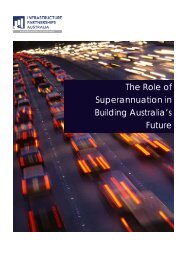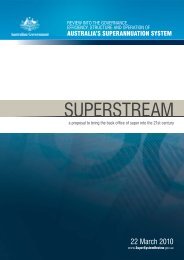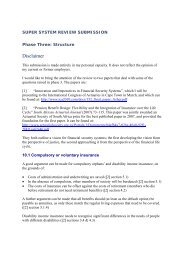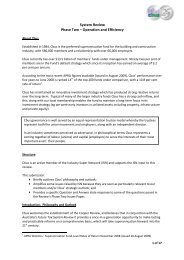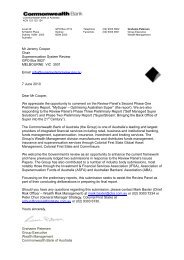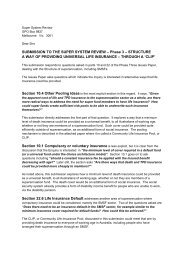Melbourne SMSF Group â Submission the Super System Review
Melbourne SMSF Group â Submission the Super System Review
Melbourne SMSF Group â Submission the Super System Review
Create successful ePaper yourself
Turn your PDF publications into a flip-book with our unique Google optimized e-Paper software.
THE MELBOURNE <strong>SMSF</strong> GROUP\Mr Jeremy CooperChairman of <strong>the</strong> <strong>Super</strong> <strong>System</strong> <strong>Review</strong> Panelinfo@supersystemreview.gov.au 15 th February 2010Dear Sir,Re: <strong>Submission</strong> to <strong>Super</strong> <strong>Review</strong> Panel regarding Self Managed <strong>Super</strong>- FundsThe <strong>Melbourne</strong> <strong>SMSF</strong> <strong>Group</strong> is a non profit, self help organization providing a regularforum for <strong>SMSF</strong> Trustees to exchange information and ideas regarding <strong>the</strong> operation ofSelf Managed <strong>Super</strong> Funds. The group has been operating for six years, and in that timehas grown, by word of mouth, to over 150 members.We believe we fulfil a valuable role in fostering Trustee involvement and learning, andencouraging responsible <strong>SMSF</strong> management.The key objectives of our group are to:• Promote compliance with <strong>the</strong> SIS Act and Tax Legislation.• Promote self education and sharing of information between <strong>SMSF</strong> Trustees• Gain educational assistance from <strong>the</strong> ATO, Centrelink and o<strong>the</strong>r organisations.• Promote clarity and simplicity in <strong>the</strong> practical operation of Self Managed Funds.• Promote sound investment practice, and <strong>the</strong> preservation of retirement savings.• Discourage <strong>the</strong> use of <strong>SMSF</strong>s where obviously inappropriate.In response to your request for suggestions aimed at improving <strong>the</strong> <strong>Super</strong>annuation<strong>System</strong>, we wish to make <strong>the</strong> accompanying submission proposing reforms to improveand simplify management of Self Managed <strong>Super</strong> Funds.We believe that suggestions we have made will offer significant advantages to thoseAustralians prepared to fund <strong>the</strong>mselves in retirement, and also produce benefits for <strong>the</strong>ATO, as regulator - and ultimately <strong>the</strong> Government Purse.As far as we are aware we are <strong>the</strong> only organisation of our type in Australia. As a grouprun by <strong>SMSF</strong> trustees, for <strong>SMSF</strong> trustees, with no commercial affiliations, we are able toappreciate and present an informed view from <strong>the</strong> <strong>SMSF</strong> Trustee perspective.We would welcome <strong>the</strong> opportunity to provide fur<strong>the</strong>r detail or comment to support anyaspect of our proposal, if required.Yours faithfully,Viv Elliston Wolfgang Waffler(Chairman) (Secretary)Issued 15 th February 2010
THE MELBOURNE <strong>SMSF</strong> GROUPSecretary: Wolfgang Waffler (email monika.waffler@bigpond.com, Phone 03 9762 7919)Chairman: Viv Elliston (vivell@melbpc.org.au, Phone 03 9803 4319)<strong>Submission</strong> Regarding Simplification of Self Managed<strong>Super</strong>annuation Funds1. Summary of Reforms Proposed in this <strong>Submission</strong>The reforms suggested in this submission are proposed by experienced <strong>SMSF</strong> Trusteeswho actively manage <strong>the</strong>ir own Funds, and see a significant level of unnecessarycomplexity and cost, that could easily be reduced or eliminated. The reforms to becovered in fur<strong>the</strong>r detail in this document include:• Addressing inappropriate promotion of <strong>SMSF</strong>s where it would not be in <strong>the</strong> bestinterests of <strong>the</strong> proposed members.• Elimination of <strong>the</strong> totally unnecessary requirement for a single member <strong>SMSF</strong> tohave a Corporate Trustee – especially where <strong>the</strong> member is in fact <strong>the</strong> soleCorporate Trustee.• Elimination of <strong>the</strong> requirement for preparation of complex Annual AccountingStatements, and <strong>the</strong>ir replacement with a simpler arrangement linked directly to <strong>the</strong>ATO.• Elimination of <strong>the</strong> requirement for annual audits of <strong>SMSF</strong>s, and <strong>the</strong>ir replacementwith <strong>the</strong> simpler and more effective ATO Self Audit process, which in essencealready exists as part of <strong>the</strong> Fund’s Regulatory Return.• Elimination of <strong>the</strong> requirement for Actuary Certificates, and <strong>the</strong>ir replacement withkey information to be provided as part of <strong>the</strong> Fund’s Regulatory Return.• As an alternative to <strong>SMSF</strong>s, we are also proposing <strong>the</strong> introduction of much simplerand more accountable means of identifying Personal <strong>Super</strong>annuation Assets, whichcould be applied at an Individual Taxpayer level.We would urge <strong>the</strong> review team to give real consideration to <strong>the</strong> above proposals, and <strong>the</strong>advantages <strong>the</strong>y would offer to <strong>the</strong> Government, <strong>the</strong> ATO, and those worthy, andsometimes senior, Australians who have accepted <strong>the</strong> responsibility to fund <strong>the</strong>mselves inretirement.2. IntroductionMany Australians have taken responsibility for funding <strong>the</strong>ir own retirement, using savingsheld in ATO supervised Self Managed <strong>Super</strong> Funds. These small funds are limited to fourmembers, and typically hold <strong>the</strong> retirement savings of individuals or couples.Issued 15 th February 2010
Many current requirements impose totally unnecessary cost and complexity, resulting in<strong>the</strong> need to put in considerable ongoing effort, or engage expensive professionals, for noreal benefit to <strong>the</strong> Government, <strong>the</strong> ATO, or self funded Australians.It is clearly in <strong>the</strong> interest of <strong>the</strong> Government to assist and encourage those who havetaken responsibility for funding <strong>the</strong>ir own retirement, especially where such assistance isnon-financial in nature.It is also important to recognize that as Self Funded Australians move into old age, <strong>the</strong>yare faced with this unnecessary burden, in order to simply manage retirement savings.This should not be <strong>the</strong> case, and if we have any pride in <strong>the</strong> fairness of our country, <strong>the</strong>seunnecessary and unproductive requirements should be reformed.It should also be recognized that as <strong>the</strong> number of Self Managed <strong>Super</strong> Funds hasincreased rapidly in recent years, a small industry has evolved in order to service <strong>the</strong>seunnecessary complex requirements. In a free market system one cannot blame thisindustry for resisting reform, and some consideration needs to be given to managing anynecessary transition, in a constructive manner.This submission presents a set of initiatives that would simplify <strong>the</strong>se small super funds, to<strong>the</strong> benefit of self funded Australians, and ultimately <strong>the</strong> Government Purse, and <strong>the</strong>community as a whole.3. Current Problems with <strong>SMSF</strong>s3.1 Inappropriate FundsSelf Managed <strong>Super</strong> Funds offer a number of important advantages to those wishing tofund <strong>the</strong>ir own retirement. Trustees (members) have full control over where savings areinvested, have greater strategic and investment flexibility, and do not have to payexcessive fees based on percentage of capital.However <strong>the</strong>re are cases where a <strong>SMSF</strong> may not be <strong>the</strong> best strategic or financial option.Some Trustees may not have <strong>the</strong> interest or <strong>the</strong> aptitude to run a <strong>SMSF</strong>, and may payexcessive operating costs, or may lack even <strong>the</strong> most basic of investment skills.We believe that <strong>the</strong> <strong>SMSF</strong> Service Industry is in a good position to address this issuewhen applying <strong>the</strong>ir expert knowledge in assessing <strong>the</strong> best options for individual clients.Our policy is to encourage our members to analyse <strong>the</strong>ir own situation and decide whe<strong>the</strong>ra <strong>SMSF</strong> is in fact <strong>the</strong>ir best option. We do not wish to pursue this issue fur<strong>the</strong>r - but simplyhighlight <strong>the</strong> problem and encourage <strong>the</strong> <strong>Review</strong> Team to consider ways to minimise anyblatantly inappropriate application of <strong>SMSF</strong>s.3.2 Unnecessary Regulatory ComplexityUnder superannuation law, <strong>the</strong> trustee of a <strong>SMSF</strong> is required to comply with significantregulation, including <strong>the</strong> following:• Administration of <strong>the</strong> fund in compliance with <strong>the</strong> SIS Act, SIS Regulations, ando<strong>the</strong>r tax law.Issued 15 th February 2010
• Operation of <strong>the</strong> fund in full compliance with <strong>the</strong> fund’s Trust Deed.• Preparation of detailed Administrative Records for <strong>the</strong> fund.• Preparation of detailed and assessable Accounting Records.• Preparation of an annual Operating Statement and Statement of Financial Positionfor <strong>the</strong> fund.• Annual lodgement of a combined income tax and regulatory return, and a number ofo<strong>the</strong>r reports, for <strong>the</strong> Tax Office.• Audit of all fund records, accounts and financial statements of <strong>the</strong> fund, each year,by an approved auditor.• Provision of a Complying Certificate for complying pensions by a certified actuary.• Provision of Tax Certificates by a certified actuary (for exempt current pensionincome) for funds that have a mixture of liabilities for pension and accumulationphases.• Preparation of and compliance with <strong>the</strong> fund’s Investment Strategy.• Retention of fund records in accordance with <strong>the</strong> requirements of <strong>the</strong> SIS act and<strong>the</strong> ATO.• Maintaining up to date calculations and records for <strong>the</strong> Tax-Free Component foreach member account.While we recognise <strong>the</strong> need for sensible regulation, we can see many opportunities toremove unnecessary, and non productive requirements, <strong>the</strong>reby reducing complexity fortrustees, as well as eliminating unnecessary costs.Unproductive complexity diverts trustee effort from <strong>the</strong> main goal of managing retirementsavings. Simplification would benefit self funded Australians, at no cost to <strong>the</strong>Government. It would help to extend savings, and ultimately reduce <strong>the</strong> need for financialsupport by Government3.3 Unnecessary “Self Imposed” ComplexityWhile some unnecessary complexity has arisen from legislation, fur<strong>the</strong>r unwarranted detailhas also been introduced. This results in over servicing, for a fee – fur<strong>the</strong>r erodingretirement savings.This is a secondary effect caused by a lack of understanding by <strong>SMSF</strong> Trustees regardingwhat is required by legislation, and what is not. The perception of complexity deters manyTrustees from breaking through <strong>the</strong> knowledge barrier, and leaves <strong>the</strong>m vulnerable tounnecessary charges.As well as being a drain on <strong>the</strong> savings of Self Funded Australians, this unproductiveeconomic effort contributes nothing to our nations useful output or wealth.We suggest that most of this unprofitable effort could be removed without anydisadvantage, and also make <strong>the</strong> lives of Self Funded Australians a great deal easier.Issued 15 th February 2010
3.4 Uninvolved TrusteesOur <strong>Group</strong> strongly promotes active involvement of Trustees in <strong>the</strong> operation of <strong>the</strong>ir<strong>SMSF</strong>s. Many members first joining our group show evidence of significant underinvolvementin <strong>the</strong> management of <strong>the</strong>ir Funds.Based on experience, we believe that many more Trustees would have greaterinvolvement, achieve better compliance, and better preserve <strong>the</strong>ir retirement savings, if<strong>the</strong>y had ready access to good information.The ATO, as regulator, provides excellent information for Trustees of Self Managed <strong>Super</strong>Funds in a number of clear, and simple booklets, which are readily available. The ATOalso supplies considerable information on <strong>the</strong>ir website, and runs informative <strong>SMSF</strong>seminars. We actively promote <strong>the</strong> use of <strong>the</strong>se and o<strong>the</strong>r reliable sources of informationfor Trustees.Because of <strong>the</strong> volunteer effect, we believe that a tiny input from government couldproduce a large benefit, by encouraging <strong>the</strong> establishment of o<strong>the</strong>r information sharinggroups like our own.4. Details of Proposed Reforms4.1 Simplification of Compliance Rules4.1.1 Elimination of Corporate Trustee RequirementWe believe that <strong>the</strong> current requirement for a single member <strong>SMSF</strong> to have a CorporateTrustee has no logical basis, and imposes an unnecessary and unfair level of complexityand cost. It also results in unnecessary ABN and TFN registrations on ATO Management<strong>System</strong>s.The current rules result in many single member funds having to set up a company with <strong>the</strong>sole <strong>SMSF</strong> member as director, and for this company to <strong>the</strong>n fill <strong>the</strong> role of <strong>the</strong> trustee. So<strong>the</strong> member is effectively filling <strong>the</strong> role of trustee anyway.This structure makes no logical sense, is costly, and offers absolutely no benefit to <strong>the</strong>Government, <strong>the</strong> ATO, or those willing to fund <strong>the</strong>mselves in retirement.We believe that a single member <strong>SMSF</strong> with <strong>the</strong> member as <strong>the</strong> sole trustee is a simplerand perfectly acceptable structure. There is no sensible purpose for <strong>the</strong> currentarrangement.In many cases <strong>the</strong> surviving member of a self funded retired couple will face <strong>the</strong> issue ofsetting up this pointless and costly structure, on <strong>the</strong> loss of <strong>the</strong>ir partner. We strongly urgethat this totally unnecessary and discriminatory requirement be abolished for singlemember funds, as soon as possible.Issued 15 th February 2010
4.1.2 Elimination of Complex Accounting Paperwork.The requirement for funds to produce annual Operating Statements and Statements ofFinancial Position appears a simple measure, but in fact has lead to a major accountingexercise more appropriate to large corporations. In reality <strong>SMSF</strong>s are generally dealingwith <strong>the</strong> modest savings of couples or single individuals.This requirement has led to <strong>the</strong> preparation of a great deal of complex and unnecessarypaperwork, which is usually well beyond what is required to simply identify <strong>Super</strong>annuationAssets and Income. We believe that <strong>the</strong>re are far simpler and better ways to satisfy <strong>the</strong>needs of <strong>the</strong> regulator (<strong>the</strong> ATO), as well as those of <strong>the</strong> members/trustees.The Fund Regulatory Return for <strong>SMSF</strong>s has recently been substantially revised, and nowcaptures most, if not all, of <strong>the</strong> data required to meet this objective. If <strong>the</strong>re were anyadditional requirements, <strong>the</strong>se could easily be included in future revisions of <strong>the</strong> Return.We would like to see a Fund Return which completely satisfies <strong>the</strong> needs of <strong>the</strong> ATO aswell as trustees/members, and for <strong>the</strong> requirement for extensive accounting to beeliminated. This would provide <strong>the</strong> regulator with readily available, more useful, and moretransparent data, and at <strong>the</strong> same time drastically simplify fund paperwork for self fundedAustralians.Funds would still need to keep records of all assets and transactions, as is currently <strong>the</strong>case. In order to simplify ATO audits of <strong>SMSF</strong>s, <strong>the</strong> types and format of such recordscould be standardised by <strong>the</strong> ATO to ensure uniformity of layout and content.4.1.3 Elimination of Unnecessary Annual AuditsThe obligation to conduct an annual independent audit for a small <strong>SMSF</strong> adds cost andcomplexity, and offers little or no benefit to self funded retirees, or <strong>the</strong> ATO. We believethat <strong>the</strong> audit requirement should be replaced with a simpler and more effective ATObased system for <strong>the</strong> following reasons:• Annual audits are an excessive requirement for such small entities, generallyholding <strong>the</strong> retirement savings of an individual, or couple.• Similar entities including Private Companies, Private Trusts, Partnerships andIndividuals, are not required to have <strong>the</strong>ir accounts audited annually.• Auditors take no responsibility for <strong>the</strong> fund’s compliance with regulations, ordeliberate abuse of rules. Audit reports typically have <strong>the</strong> following “disclaimer”:“The fund’s trustee is responsible for <strong>the</strong> financial report and ensuring compliancewith <strong>the</strong> requirements of <strong>the</strong> SIS Act and SIS Regulations”, and“Because of <strong>the</strong> test nature and o<strong>the</strong>r inherent limitations of an audit, toge<strong>the</strong>r with<strong>the</strong> inherent limitations of any system of internal control, <strong>the</strong>re is an unavoidable riskthat some material misstatement, fraud or irregularity will remain undiscovered”.Current audits offer little value to <strong>the</strong> Fund, because <strong>the</strong> trustee still remains solelyresponsible for compliance, and for <strong>the</strong> accuracy of all fund records and reports.• Audits are not needed to protect <strong>the</strong> interests of <strong>SMSF</strong> Members. Members mustalso be trustees and as such are unlikely to act against <strong>the</strong>ir own best interests.Issued 15 th February 2010
• Audits add to <strong>the</strong> already significant annual compliance requirements and costs for<strong>SMSF</strong>s, and erode <strong>the</strong> savings of self funded retirees, potentially resulting in <strong>the</strong>irearlier dependence on government support.• The ATO, as regulator, has a number of very helpful and effective checks andbalances, and typically conducts at least 3,600 audits on <strong>SMSF</strong>s per annum.We suggest that <strong>the</strong> current ineffective audit system is now largely redundant, andcould be replaced by <strong>the</strong> ATO Tax and Regulatory Return. The latest Return nowincludes a set of compulsory questions designed to target <strong>SMSF</strong> rules and particularaudit issues, with suitable penalties for deliberate supply of misinformation. This couldbe fur<strong>the</strong>r developed, if found necessary.4.1.4 Elimination of Pension Actuary CertificatesThe requirement to obtain Actuary Certificates for <strong>SMSF</strong> pension streams also involvesunnecessary complexity and cost, and offers little or no benefit to self funded Australiansor <strong>the</strong> ATO.We believe actuary requirements should be discontinued for <strong>the</strong> following reasons:• The requirement for Trustees to maintain accurate records of <strong>the</strong> value of pensionentitlements for each member would not be diminished, and compliance can beverified at any time by ATO Audit.• Actuary Certificates are not needed to protect <strong>the</strong> interests of <strong>SMSF</strong> Members. Thefund trustees are also members and as such have no reason to deprive <strong>the</strong>mselvesof pension entitlements.• The Actuary Certificate is simply a reflection of information which has already beenestablished and provided by <strong>the</strong> Trustee, and as such provides no additionalinformation or benefit.• The ongoing longevity and sustainability of a pension depends on <strong>the</strong> performanceof investments chosen by <strong>the</strong> trustees. The existence of an Actuary Certificate inno way guarantees <strong>the</strong> performance of <strong>the</strong>se investments.• Actuary Reports and Certificates also add to <strong>the</strong> already significant annualcompliance costs for <strong>SMSF</strong>s, and erode <strong>the</strong> savings of self funded Australians,potentially resulting in <strong>the</strong>ir earlier dependence on government support.4.2 Personal <strong>Super</strong>annuation Accounts4.2.1 The ConceptIn addition to considering <strong>the</strong> above reforms we invite <strong>the</strong> <strong>Review</strong> Team to consider <strong>the</strong>concept of superannuation savings from a new perspective.As an alternative to <strong>SMSF</strong>s, we are proposing <strong>the</strong> introduction of much simpler and moreaccountable means of identifying Personal <strong>Super</strong>annuation Assets, which could be appliedat an Individual Taxpayer level.Issued 15 th February 2010
We propose <strong>the</strong> introduction of <strong>the</strong> concept of simple ATO based “Personal<strong>Super</strong>annuation Accounts” for Individuals. We suggest that <strong>the</strong>se accounts could have <strong>the</strong>following features:• Australians would be able to establish ATO Personal <strong>Super</strong>annuation Accounts.Such an account would apply to an individual taxpayer only.• Assets held in Personal <strong>Super</strong> Accounts would need to be separately identified fromo<strong>the</strong>r assets, as is currently <strong>the</strong> case for <strong>SMSF</strong> assets• <strong>Super</strong>annuation savings would be reported under an individuals existing Tax FileNumber, in <strong>the</strong> Supplementary Section of <strong>the</strong>ir Personal Tax Return.• <strong>Super</strong>annuation assets would simply be attributed to an individual, and as suchwould be readily identifiable, and accounted for.• The need for trust deeds, trustees, and complex accounting would be eliminatedalong with much o<strong>the</strong>r unnecessary complexity, and <strong>the</strong> associated expense.• Personal <strong>Super</strong> Accounts would allow investment in cash, shares, property, andany o<strong>the</strong>r asset class currently available to <strong>SMSF</strong>s.• The ATO could define <strong>the</strong> format in which personal super records are to be kept toensure uniformity. These standardised records would be auditable at any time by<strong>the</strong> ATO.• A simple rule booklet should be available to anyone wishing to run a Personal<strong>Super</strong>annuation Account, and participants should be required to possess a copyand be familiar with its contents• The ATO Tax Return could include compulsory questions designed to targetparticular rules or audit issues, with suitable penalties for deliberate supply ofmisinformation.4.2.2 Summary of BenefitsWe see major benefits from such an arrangement including:• It provides a viable alternative for individuals wanting a simple structure foridentifying and managing <strong>the</strong>ir own retirement savings.• <strong>SMSF</strong> costs, which especially penalise those with modest savings, would beeliminated.• Many of <strong>the</strong> current compliance problems associated with <strong>the</strong> more complex <strong>SMSF</strong>option could be avoided.• ATO Auditors would not need to pour through complex and unnecessarydocumentation currently produced for <strong>SMSF</strong>s.• Self Funded Australians would be freed up to concentrate on managing <strong>the</strong>irsavings instead of involvement in a great deal of unnecessary and non productivecompliance effort.• We believe that Many Self Funded Australians would choose this simpler option,resulting in reduced <strong>SMSF</strong> compliance effort by <strong>the</strong> ATO.Issued 15 th February 2010
5. Long term Impact of ongoing costs5.1 Basic Compliance CostsTo put our concerns regarding costs in perspective, we estimate <strong>the</strong> basic annualcompliance costs for <strong>the</strong> running of a Self Managed Fund to be as follows:Accumulation Phase Pension PhaseTypical Cost ($) Typical Cost ($)Accounting 2,000 2,000Audit 600 600Tax and Reg. Return 200 200Misc Service Costs 400 400Actuary Certificate (ea) 0 250Complying Certificate (ea) 0 450ATO <strong>Super</strong>visory Levy 150 150Totals $3,350 $4,050Where required, <strong>the</strong> cost of setting up a corporate trustee arrangement for a single person<strong>SMSF</strong> would be between $700 and $1,000, plus an ongoing annual ASIC fee.5.2 Long term impact on retirement savingsOngoing annual regulatory costs can seriously impact on retirement savings over <strong>the</strong> life ofa <strong>SMSF</strong>. It is not only <strong>the</strong> impact of <strong>the</strong> leakage of capital, but also <strong>the</strong> cumulative loss ofearnings this lost capital would have generated.If <strong>the</strong> effect of <strong>the</strong>se costs is modelled from age 65 to age 85, <strong>the</strong> total cumulative costwould be about $170,000 – in real terms.This is based on an average annual compliance cost of $3,800, with allowance for loss ofearnings on deducted expenses at a rate of 8% above inflation. This figure is <strong>the</strong> “real”amount expressed in today’s dollars. We believe that this represents a significant erosionof an individual’s retirement savings.5.3 Overall impact on national <strong>SMSF</strong> retirement savingsThere are currently about 420,000 <strong>SMSF</strong>s operating in Australia. Based on <strong>the</strong> abovefigures <strong>the</strong> total erosion of retirement savings for <strong>the</strong>se funds over <strong>the</strong> 20 year periodwould be a staggering $70 billion, or $3.5 billion per year. We believe that <strong>the</strong>se figuresare substantial and justify a re-think of <strong>the</strong> current compliance requirements.We also believe that over time Centrelink must ultimately make up for much of this loss asretirement savings are eroded.Issued 15 th February 2010
6. SummaryIn summary we believe that <strong>the</strong> current <strong>SMSF</strong> regulatory requirements we havesubstantially contributed to higher costs which erode savings, and discourage greaterdirect involvement by Trustees.In addition we believe that <strong>the</strong>se requirements offer little value to <strong>the</strong> Government, <strong>the</strong>ATO, or self funded Australians, and eventually have a financial impact on <strong>the</strong>Government Purse.It is also important to recognise that many of those Australians who take responsibility forfunding <strong>the</strong>ir own retirement do so into old age, at which stage <strong>the</strong>y do not deserve to befacing totally unnecessary complexity or bureaucracy in simply managing basic retirementsavings.We <strong>the</strong>refore recommend that <strong>the</strong>se proposals be given serious consideration as part of<strong>the</strong> current effort to simplify and improve Australia’s <strong>Super</strong>annuation and Taxationsystems.Viv Elliston Wolfgang Waffler(Chairman) (Secretary)Issued 15 th February 2010



